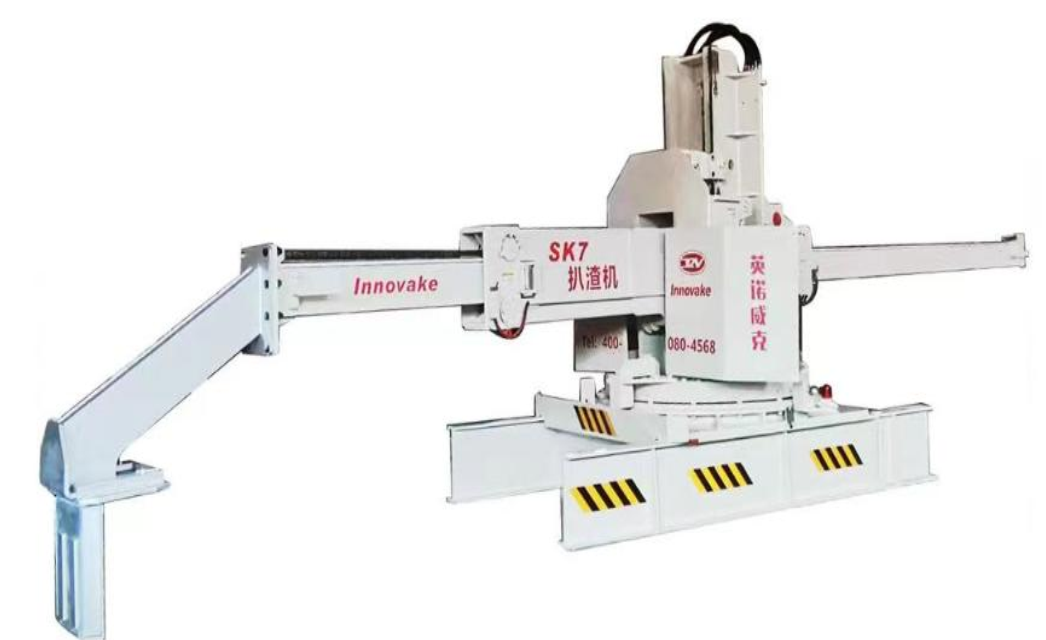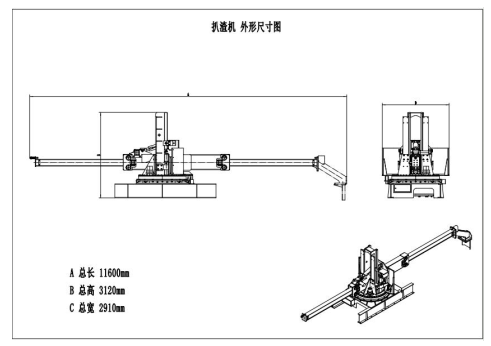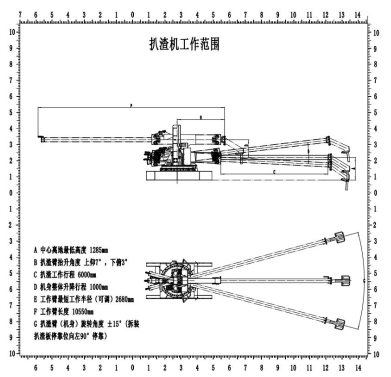Desulfurization Slag Skimming Machine
1. Introduction
In the steelmaking and non - ferrous metal smelting industries, desulfurization is a crucial process step. During desulfurization, a significant amount of slag is generated on the surface of molten metal. This slag, if not removed effectively, can have adverse effects on the quality of the final metal product, such as reducing its purity and mechanical properties. The desulfurization slag skimming machine has emerged as an essential piece of equipment to address this issue, ensuring the efficient removal of slag from the molten metal surface during the desulfurization process.

2. Working Principle of the Slag Skimming Machine
2.1 Detection and Approach
Most modern slag skimming machines are equipped with sensors, such as infrared sensors or cameras. These sensors are used to detect the position and thickness of the slag layer on the surface of the molten metal. Once the slag layer is detected, the machine adjusts its position to approach the slag area accurately. For example, in some automated systems, the sensor data is fed into a control system, which then calculates the optimal path for the skimming device to reach the slag - covered area of the molten metal surface.
2.2 Skimming Mechanism
There are several common skimming mechanisms.
2.2.1 Rake - type Skimming
The rake - type slag skimming machine features a rake - like structure. When the machine reaches the slag area, the rake is lowered onto the surface of the molten metal. The teeth of the rake dig into the slag layer, and then through the movement of the rake arm (which can have forward - backward, left - right, and vertical movements), the slag is scraped and collected. The rake arm is usually hydraulically or mechanically driven. For instance, in a steelmaking ladle, a hydraulic - driven rake arm can be precisely controlled to adjust the depth of the rake in the slag layer, ensuring effective slag removal without disturbing the molten metal too much.
2.2.2 Paddle - type Skimming
Paddle - type slag skimming machines use a flat paddle - shaped device. The paddle is immersed in the molten metal at an appropriate angle to scoop up the slag. As the paddle moves across the molten metal surface, the slag adheres to the paddle due to its surface tension and viscosity. The paddle is then lifted, and the collected slag is dumped into a slag - collection container. In some applications, the paddle can be designed with special coatings to enhance its slag - adhesion ability and prevent the molten metal from adhering to it, which helps in separating the slag more cleanly.
2.2.3 Suction - type Skimming
Suction - type slag skimming machines create a negative pressure environment. A suction nozzle is placed close to the slag layer on the molten metal surface. The negative pressure sucks the slag into a collection chamber through the nozzle. The suction force can be adjusted according to the thickness and viscosity of the slag. This type of skimming machine is particularly useful for removing fine - grained or low - viscosity slag, as it can precisely control the amount of slag being removed without sucking in too much molten metal.
3. Types of Desulfurization Slag Skimming Machines
3.1 Manual - operated Slag Skimming Machines
Manual - operated slag skimming machines are the simplest in design. They are mainly used in small - scale smelting workshops or in situations where the production volume is relatively low. Workers directly control the movement of the skimming device, such as a hand - held rake or paddle. Although they require more labor and have lower efficiency compared to automated machines, they are cost - effective for small - scale operations and can be easily adjusted according to the actual situation on - site.
3.2 Semi - automated Slag Skimming Machines
Semi - automated slag skimming machines combine some automated functions with manual operation. For example, the movement of the skimming arm in the horizontal direction may be automated, controlled by a motor, while the vertical movement of the skimming device (rake or paddle) is still manually adjusted by the operator. This type of machine can improve work efficiency to a certain extent while still maintaining some flexibility for operators to adapt to different slag - removal requirements.
3.3 Fully Automated Slag Skimming Machines
Fully automated slag skimming machines are highly advanced. They are equipped with a complete set of sensors, control systems, and actuators. The entire slag - skimming process, from slag detection to removal and collection, is automated. The control system can adjust the operation parameters of the machine in real - time according to the sensor - monitored data, such as the thickness and distribution of the slag layer. These machines are widely used in large - scale steelmaking and non - ferrous metal smelting plants, where high - efficiency and precise slag removal are required to ensure production quality and productivity.

4. Advantages of Using a Desulfurization Slag Skimming Machine
4.1 Improved Metal Quality
By effectively removing slag from the surface of molten metal, the desulfurization slag skimming machine can prevent the slag from re - entering the molten metal during subsequent processing steps. This significantly reduces the inclusion of impurities in the metal, thereby improving the purity and quality of the final metal product. For example, in steelmaking, reducing slag inclusions can enhance the mechanical properties of steel, such as its strength, toughness, and fatigue resistance.
4.2 Increased Production Efficiency
Compared with manual slag - removal methods, slag skimming machines can complete the slag - removal process more quickly. Automated and semi - automated machines can operate continuously, reducing the time required for each slag - removal cycle. This allows for a shorter overall production cycle, increasing the output of the smelting plant. In a large - scale steelmaking plant, the use of high - efficiency slag skimming machines can increase the daily production of steel by a significant amount.
4.3 Reduced Labor Intensity
Manual slag removal is a labor - intensive and harsh - environment task. Workers need to be close to the high - temperature molten metal, which poses safety risks. The use of slag skimming machines can greatly reduce the need for workers to perform such dangerous and strenuous work. Workers only need to monitor the operation of the machine and perform some simple maintenance tasks, improving the working environment and reducing labor intensity.
4.4 Cost - effectiveness in the Long Run
Although the initial investment in purchasing a slag skimming machine may be relatively high, in the long run, it can bring significant cost savings. By improving metal quality, the number of defective products can be reduced, saving costs associated with re - processing or scrapping. The increased production efficiency also means that more products can be produced with the same amount of resources, increasing revenue. Additionally, the reduction in labor requirements can cut down on labor costs.
5. Application Scenarios in Different Industries
5.1 Steelmaking Industry
In the steelmaking process, especially during the hot metal desulfurization stage in the ladle or converter, the desulfurization slag skimming machine is widely used. After injecting desulfurizing agents such as magnesium and lime into the hot metal, a large amount of slag is formed on the surface. The slag skimming machine effectively removes this slag, ensuring that the molten steel is of high quality before further refining or casting processes.
5.2 Non - ferrous Metal Smelting Industry
5.2.1 Aluminum Smelting
In aluminum smelting, during the refining process to remove impurities and gases, slag is generated. The slag skimming machine is used to remove this slag, which helps to improve the purity of aluminum and its alloy products. The clean aluminum is then suitable for producing high - quality aluminum products, such as those used in the aerospace and automotive industries.
5.2.2 Copper Smelting
Similarly, in copper smelting, after desulfurization and other purification steps, the slag formed on the surface of molten copper needs to be removed. The slag skimming machine can accurately remove the slag, ensuring the quality of the molten copper for subsequent processing into various copper products, including wires, sheets, and pipes.
6. Technological Development Trends of the Slag Skimming Machine
6.1 Higher Precision and Intelligence
With the development of artificial intelligence and sensor technology, future slag skimming machines will be able to achieve even higher precision in slag detection and removal. Advanced sensors will be able to distinguish between slag and molten metal more accurately, and the control system will be able to adjust the skimming operation in real - time based on more complex algorithms. For example, machine - learning algorithms can be used to analyze the sensor data and optimize the skimming process, improving the efficiency and quality of slag removal.
6.2 Integration with the Overall Production System
Slag skimming machines will be more closely integrated with the overall smelting production system. They will be able to communicate with other equipment in the production line, such as ladle turntables, furnaces, and casting machines. This integration can enable better coordination of the production process, for example, automatically adjusting the slag - skimming operation according to the production rhythm of the entire smelting process, reducing waiting times and improving overall production efficiency.
6.3 Energy - saving and Environmental - friendly Design
In response to the global trend of energy conservation and environmental protection, slag skimming machine manufacturers will focus on developing energy - saving models. New materials and design concepts will be applied to reduce the energy consumption of the machine during operation. At the same time, efforts will be made to minimize the generation of dust and other pollutants during the slag - skimming process, making the smelting industry more environmentally friendly.

7. Conclusion
The desulfurization slag skimming machine plays a vital role in the metal smelting industry. Its application has brought about significant improvements in metal quality, production efficiency, and labor conditions. As technology continues to advance, slag skimming machines will continue to evolve in terms of intelligence, integration, and environmental friendliness, further promoting the development of the metal smelting industry towards a more efficient and sustainable direction.


